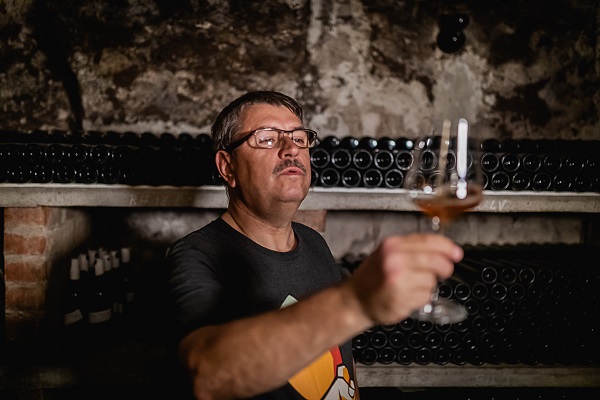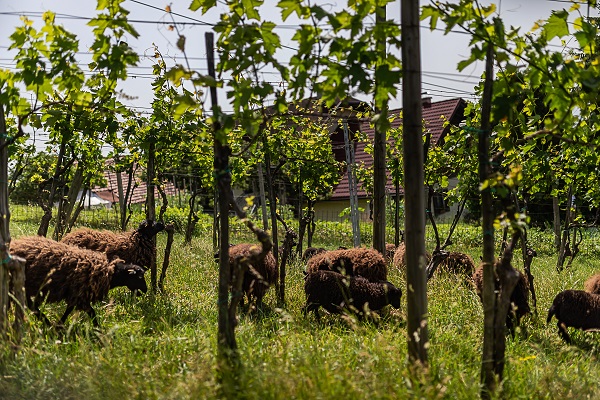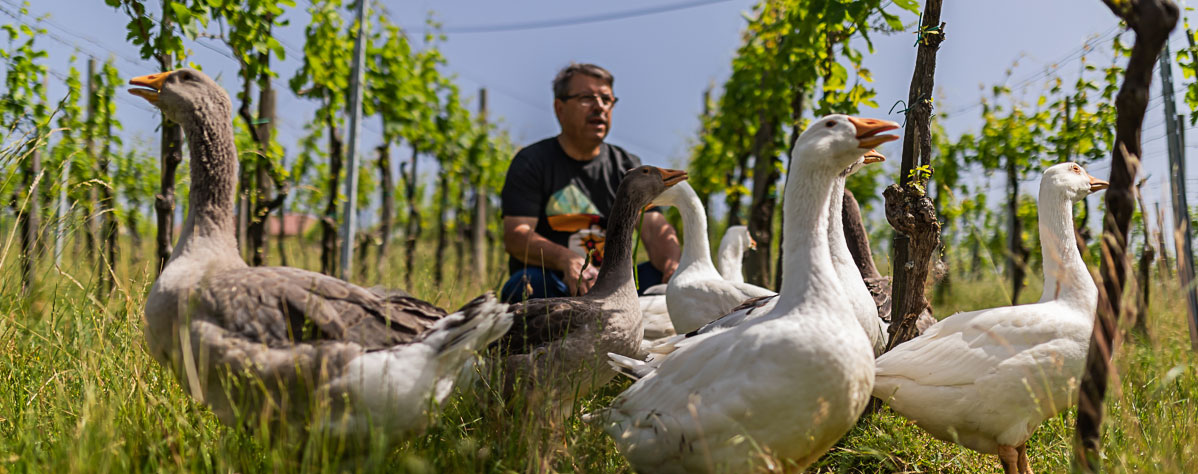Božidar has been quietly doing his own thing – making orange wines in amphora – since 1995. In other words, well before Gravner and Radikon embarked on their more famous journeys down this route.
Author Simon J Woolf first brought Božidar to my attention in the book Amber Revolution. Then, last year, Woolf proclaimed Zorjan’s Dolium Muskat Ottonel to be one of the two best orange wines in the world (alongside Austrian family Heinrich’s Graue Freyheit).
Having tried Božidar Zorjan’s Dolium Muskat Ottonel for the first time last month, there’s no argument from me. It’s the best orange wine I’ve tasted. And it’s the only wine I’ve craved long after the last sip. It’s been nine days since I visited the Zorjan farm, Trajnostno Kmetovanje Zorjan, in the Slovenian part of Styria, and each day since, I’ve longed to revisit the hedonistic wine’s clementine-like flavours and subtle floral aromas. That’s never happened to me before.
For a wine that’s had six months’ skin contact, a year of ageing in amphora and several more in oak, it has a light, elegant texture. It also has an amazingly long finish – often described as “a deep embrace” – that I’m hankering after right now. But, in the absence of the wine, I’m wondering what makes it so special?

I’ve come up with seven reasons because seven is a special number for biodynamic farmers like Božidar Zorjan (above).
As I drive into the 7ha farm in the hilly Tinjska Gora, on the southern slopes of the Pohorje Massif (between the historic wine towns of Maribor and Ptuj), I’m greeted by seven geese. The vineyard grows seven white varieties (Laški rizling, Riesling, Chardonnay, Rumeni Muskat, Muskat Ottonel, Ranina, and Sylvaner) and two reds. There are seven amphorae buried in the grounds around the winery and there are seven deer in an enclosure in the forest.
1 Is it the terroir?
I spent more than three hours with Božidar and he never once mentioned the T-word. But, obviously, it plays a part.The Zorjan farm, in the Štajerska subregion of Podravje, sits on the igneous rocks of Pohorje, a medium-high mountain range in northeast Slovenia. The rocks are covered only by a very thin layer of fertile soil, so much of the region is wooded. On the edges of the forest is the farm that Božidar and his wife, Marija, inherited in 1980, quickly converting to organic farming before going on to become Demeter certified for their biodynamic practices.
Although Božidar didn’t talk about terroir, he is very focused on the soil and reanimating its fertility through biodynamic preparations, which are used to create composts and sprays. The preps made from yarrow, chamomile, stinging nettle, oak bark, dandelion, and valerian are buried in separate spots in the three vineyards. There are compost heaps at the foot of each parcel.
Božidar spends a long time talking about the health of the soil and how composting connects the animal manures, vines and soil.
Soil is one of the three key things that a winemaker needs to understand to make wines that are “alive”, Božidar explains through a translator. The other two things are:
- The cosmos. It’s important to observe and understand the rhythms and cycles of the earth, sun, moon, stars, and planets, and the subtle ways they influence the growth and development of the vines and berries.
- Amphorae. Most of Božidar’s wines spend a year in clay, which is buried outside in direct contact with the soil and under the stars.
2 Is it the vineyard?
Božidar’s 7ha farm comprises 4ha of vineyards, 2ha of forest and 1ha of grassland and orchard.The land once belonged to the Žiče monastery, so there always has been a spiritual element to the property. When the Carthusians closed the monastery, the land and buildings were sold. Zorjan’s ancestors purchased a little land and the small cellar. This impressive, arched cellar now hosts some of the special biodynamic preps and brandies made from the grape skins. The farmhouse has been built on top of it and a new cellar has been built next to it.
The Muskat Ottonel vineyard, planted in 1993, is surrounded by trees. The density is 4,200 vines per hectare and the yield is a mere 0.5kg per plant – producing about 1,000 bottles a year.
The low yield and special location obviously play a part.
3 Is it the grape?
In Slovenia, Muskat Ottonel is usually made in a semi-sweet style. Consequently, it’s not among my favourite grapes. But here, it is much less perfumed than usual and fermented dry.Normally the palest of the Muscats, here it is a wonderful amber colour. With the extended skin contact and ageing, it takes on a new, exciting, more subtle and finessed identity.

4 Is it the farming method?
Winemaker Božidar Zorjan is a passionate advocate of Rudolf Steiner’s holistic, ecological, and ethical approach to farming. In fact, he takes biodynamic farming to the nth degree, so this really is a crucial factor.A flock of Ouessant sheep from Brittany and a gaggle of geese graze freely among the vines. A small herd of deer is corralled in an adjoining forest. He uses their meat for food and their bladders for the yarrow preparation.
As we toss windfall apples over the high fence to the stag, Felix, who’s lost a lot of weight during the mating season, Božidar explains the importance of having diverse domestic animals on the land. Each contributes a unique quality of manure to the soil, he says.
Božidar often comes to the forest to watch the animals, learn from their behaviour, listen to the land, and learn from nature.
He bought his part of the forest to add biodiversity to the farm and make it an integrated, whole, living organism made up of many interdependent elements: the vineyards with the biodynamic preparations buried in them and the compost at the bottom, the grass areas which are cut only twice a year (once for animal feed and once to add to the compost), the untouched forest, the wide range of plants, the animals, and soil – with the winemaker and his wife, Marija, at the centre of the system.
I’ve been to many biodynamic farms, but this is the only one where I’ve been instructed to leave my mobile phone in the car. Božidar doesn’t allow them in the vineyard, winery, cellar or tasting room in case they “disturb the energy”. He also advises against customers having their phones out while drinking the wine. The back labels on the bottles carry a ‘no mobile phone’ illustration. He believes they affect human thinking, fertility and health, and will ‘kill’ a living wine.
He also got rid of the hail and bird nets because they are made of plastic.
5 Is it the amphora?
Amphorae with capacities of 500 to 2,500L are buried in pits outside, around the winery. They are very important to the process – but also for philosophical reasons.Probably the first in Europe to use amphorae for winemaking in the modern era, he uses them because of clays’ connection to earth and because they are buried outside in the soil – and are therefore part of the cosmos. He is critical of other winemakers who use amphorae “like barrels”.
Apart from tossing the whole bunches in and giving them the occasional gentle stir, Božidar does very little to the juice and wine while it’s in the unlined amphorae. He says he just lets the “cosmic forces” turn the grapes into wine over the winter. This, he says, gives “us a unique live wine, where the man with his ego is just a mere observer”.
6 Is it the winemaker?
It’s his decision to be low-intervention in the vineyards and cellar. It’s his decision to be biodynamic. So, yes, this is another important contributing factor.It’s also his decision to keep a low profile, which I admire. If my wines were this amazing I would shout it from the rooftops. If I had been the first winemaker in Europe to return to using amphorae, I would let everyone know. But Božidar remains focused on producing healthy soils and living wines. That’s what’s important to him. Not accolates or fame.
‘We do what we absolutely need to, everything else is clutter’
7 Is it the winemaking?
Along with the choice to be biodynamic, the decision to be hands-off is crucial for the development of his wines.Božidar’s approach is: “We do what we absolutely need to, everything else is clutter.”
- Whole bunches are put in the amphora.
- Native yeasts are used for the fermentation.
- Punchdowns are too brutal for delicate grapes, so there is only gentle stirring – “as if you were making soup”.
- The wine stays on skins for six months before racking to a smaller amphora.
- It completes MLF naturally.
- The wine stays in the second amphora for another six months – basically until the next harvest, so the amphora is never empty for long and never needs to be cleaned.
- After a year in amphora, the wine is pumped into the cellar for ageing in an old 1,200L Slovenian oak barrel.
- It ages for a minimum of three years in barrel because that’s how long the yeasts need to complete their journey from life to spirit to decay (a year for each).
- The wine is bottled unfined, unfiltered and with no added sulphites.
- It ages in a screw-capped bottle for another year (at least) before release.
The wine was served at room temperature and he recommends it’s served between 16 and 22°C. Once open, he says it will last 40 days.
I can't believe anyone would leave it that long before taking another sip.













.png)






